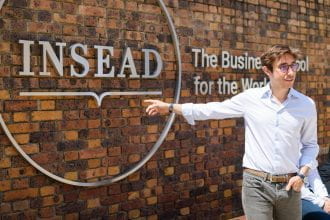 Human behaviour is under the microscope at the INSEAD-Sorbonne University Behavioural Lab
Human behaviour is under the microscope at the INSEAD-Sorbonne University Behavioural Lab
In the heart of the Latin Quarter in Paris, right behind a set of glass doors at 6 rue Victor Cousin, you can find what many people describe as “INSEAD’s best-kept secret.”
This is the home of the INSEAD-Sorbonne University Behavioural Lab, a state-of-the-art research lab that runs some of today’s most innovative studies in behavioural science. Open to faculty members and PhD students from across INSEAD and its research associates grouped in the Sorbonne University research cluster, the lab supports research studies that explore human perception, motivation, decision-making, consumption, negotiation and more. Since its founding in 2002, the lab has hosted more than 92,000 participants for hundreds of multidisciplinary studies, leading to 128 scientific publications in peer-reviewed journals.
“This is a pretty diversified operation,” says Pierre Chandon, the L’Oréal Chaired Professor of Marketing at INSEAD and director of the lab. “We do all sorts of studies aimed at understanding human behaviour,” with recent studies exploring topics such as affective computing and artificial intelligence, creativity and cross-cultural psychology, and health, nutrition and wellbeing.
“We want to understand how people actually behave—not how they should behave based on economic theory,” Pierre continues. “This lab allows us to do that.”
 Flexibility meets high tech
Flexibility meets high tech
Thanks to a partnership established with Sorbonne University in 2014, the lab has access to some of the most advanced research equipment available today, which enables researchers to conduct a variety of high-tech behavioural studies. The lab’s current inventory includes eye trackers, electroencephalogram recorders, skin conductance recorders, facial expression recognition software and even the kind of motion-capture software typically used by animation studios.
“We do a lot more physiological research now,” explains Liselott Pettersson, who has overseen the lab as assistant director for more than 15 years. “We’re able to check people’s emotions by putting electrodes on them. We’re able to do role play. It really goes beyond the pen-and-paper surveys.”
Under Liselott’s direction, the lab’s operations are run by a full-time team of multilingual behavioural scientists, who provide translation and programming services, access to respondents, payment processing, data entry, analysis and accounting support, and a range of other services. All of the team members have backgrounds in experimental research, which gives them the expertise needed to consult on the design and execution of experiments.
“We are here to help researchers set up the study or brainstorm how to go about the study, but we don’t meddle,” explains Lisette. The lab does not impose a research agenda; professors and PhD students are free to conduct studies as they wish, so long as they abide by the lab’s ethical guidelines.
With that kind of open policy, the lab has been able to facilitate multidisciplinary studies that inform research and practice in interesting ways. One INSEAD study found that emphasizing the presence of Red Bull energy drink in an alcoholic cocktail made young men feel drunker, take more risks, and be more confident around women—even without changing what they had been actually drinking. Another INSEAD study in progress found that women were more willing to take risks when they wore high-heel shoes in the company of others, men or women. A Sorbonne University study conducted in the lab, found that people’s emotions can be influenced by covertly manipulating how their own voice sound (i.e., happy or sad).
Some of the studies conducted at the lab are examining how business can be a force for good. For example, a study conducted by Pierre and Yann Cornil, which was published in the Journal of Marketing Research and later covered in INSEAD Knowledge, showed that people prompted to focus on the multi-sensory experience of eating are more satisfied with less food and are willing to pay more for smaller portions. “A triple win for health, business and eating pleasure,” says Pierre.
Advancing INSEAD
Beyond generating new insights about human behaviour, the lab is helping INSEAD to grow as an educational institution while bolstering its global reputation.
“INSEAD has always been an extremely strong school, but the lab is making the school stronger on a research level,” says Pierre. He notes that the research conducted at the lab has allowed INSEAD to be among the top-10 schools on the University of Texas-Dallas’ business school research rankings.
Improving INSEAD’s research capabilities has also helped the school attract more high-calibre faculty and increase its global rankings, as the two consecutive Financial Times’ no. 1 rankings can attest. The lab’s research outcomes also typically garner hundreds of media hits each year, appearing in top-tier outlets such as The New York Times, BBC News, the Wall Street Journal and Financial Times. Self-control insights from studies conducted at the lab were even featured in one episode of the popular “Big Bang Theory” television comedy.
That media attention is likely to increase in 2018 when the lab welcomes the first Sorbonne University INSEAD Distinguished Visiting Chair in Behavioural Sciences: Wendy Wood, vice dean of research and provost professor of psychology and business at the University of Southern California, who is a world-renowned scholar and expert in the study of habits.
The lab is also growing in a literal sense. It recently leased—and started renovating—a space next to its current location. This multi-purpose space, with its high-quality link to the Singapore campus, will allow INSEAD to run more studies but also to hold meetings with individual and corporate partners. It will also serve as a showroom for INSEAD’s various education programmes.
Pierre encourages INSEAD alumni interested in research to visit the lab for private tours, which can be arranged by contacting Liselott. “When you visit the lab, you get to see the research in action,” he says. “And you finally get to know what INSEAD professors do when they are not teaching.”


